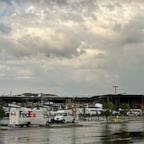Greenland's melt mystery unfolds, at glacial pace
HELHEIM GLACIER, Greenland -- Suddenly and without warning, the gigantic river of ice sped up, causing it to spit icebergs ever faster into the ocean off southeastern Greenland.
Helheim Glacier nearly doubled its speed in just a few years, flowing through a rift in the barren coastal mountains at a stunning 100 feet (30 meters) per day.
Alarm bells rang as the pattern was repeated by glaciers across Greenland: Was the island's vast ice sheet, a frozen water reservoir that could raise the sea level 20 feet if disgorged, in danger of collapse?
Half a decade later, there's a little bit of good news — and a lot of uncertainty.
"It does seem that the very rapid speeds were only sustained for a short period of time although none of these glaciers have returned to the 'normal' flow speeds yet," says Gordon Hamilton, a glaciologist from the University of Maine, who's clocked Helheim's rapid advance using GPS receivers on site since 2005.
Understanding why Greenland's glaciers accelerated so abruptly in the first half of the decade — and whether they are now slowing down — is crucial to the larger question of how fast sea levels will rise as the planet warms.
The issue has gained urgency as scientists rush to supply their latest findings in time for negotiations on a new global climate pact, set for December in Copenhagen.
Scientists say the Greenland ice sheet, which is up to 2 miles (3 kilometers) thick and covers an area almost the size of Mexico, is losing about 7 billion cubic feet (200 million cubic meters) of ice a year — the equivalent of 80,000 Olympic-sized swimming pools.
That means snowfall on top of the ice sheet is not enough to replace what is lost through surface melting and ice chucked out in the fjords by faster-flowing glaciers. In the process, sea levels rise as towering icebergs plunge into the Atlantic Ocean and displace water — much like an ice cube dropped into a drink.
The dynamics of the ice sheet on Greenland — and the much larger ones on Antarctica — were not included in sea level rise projections by the U.N. expert panel on climate change in 2007 because the phenomenon was poorly mapped at the time.




